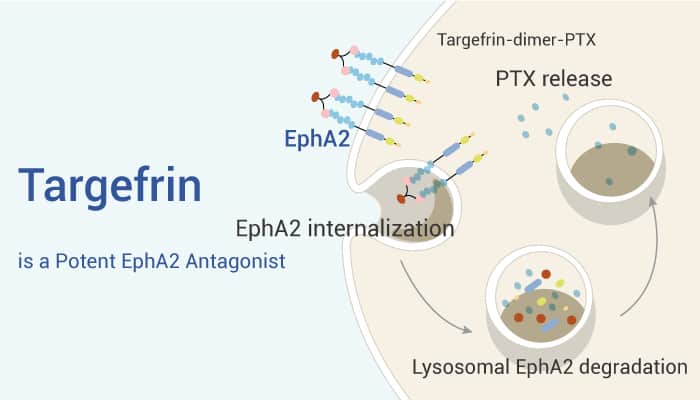EphA2, a transmembrane glycoprotein, is a type of Ephrin receptors (Eph) which is the most important class of receptor tyrosine kinases. EphA2 can be detected in most epithelial cells. In common situation, it interacts with ephrin A1 on the neighboring cell, thereby inducing diverse signaling networks following cell-to-cell contact. Ephrin A1-associated EphA2 is related with focal adhesion kinase (FAK), extracellular regulated protein kinases (ERK), and Akt phosphorylation, as well as the regulation of motility, viability, and proliferation in multiple malignant cell lines.
Altogether, the EphA2-ephrin A1 signaling regulates multiple cellular processes in embryonic development, angiogenesis, and tumorigenesis. Furthermore, EphA2 takes part in malignant progression actively. Therefore, this gene not only become a biomarker of malignant character, but also a concerned target for treating cancer.
Targefrin is a potent EphA2-targeting agent and acts as an antagonist.

Targefrin binds EphA2-LBD with a 21 nM dissociation constant and an IC50 value of 10.8 nM. It induces cellular receptor internalization and degradation in several pancreatic cancer cell lines.
According to the experiment result in vitro, Targefrin effectively antagonizes EphA2 degradation in BxPC3 pancreatic cancer cells. Also, Targefrin can inhibit pancreatic cancer cell BxPC3 migration. Additionally, it shows effective anti-tumor activity in vivo, especially with Paclitaxel. In nu/nu mice injected with MIA PaCa-2 cells, both Targefri-Paclitaxel and Targefrin-dimer-Paclitaxel display a significant antitumor effect compared to both the untreated group and the Paclitaxel-treated group.
In conclusion, Targefrin, a potent EphA2 antagonist, can be used to research pancreatic cancer.
References:
[1] Xiao T, et al. Targeting EphA2 in cancer. J Hematol Oncol. 2020 Aug 18;13(1):114.
[2] Baggio C, et al. Targefrin: A Potent Agent Targeting the Ligand Binding Domain of EphA2. J Med Chem. 2022 Nov 4.